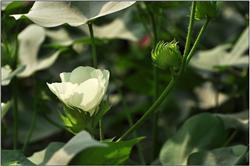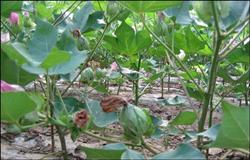Cotton planting technology: how to fertilize cotton at flowering and boll stage?

How to fertilize cotton at flowering and boll stage? Please give guidance to the cotton flower and boll period can refer to the following methods of topdressing: first, fertilizer deficiency plots to increase the amount of topdressing. In the areas with more per capita cotton planting area, some villages still maintain the state of low input and output, and the cotton planting benefit is very low. Some even apply only 10-15 kg of urea or diammonium per mu (more than 150 kg per mu of seed cotton per mu). Now cotton plants have shown a serious lack of fertilizer, especially in Nanpi County, where heavy rains have fallen, cotton fields have accumulated water, and few available nutrients in the soil have been leached and lost. Now there is an urgent need for topdressing. If the cotton field with minimum base fertilizer and no potassium fertilizer is applied, 10 kg urea and 7.5 kg high-quality potassium fertilizer should be applied per mu (potassium sulfate should be applied in saline-alkali soil). If potash fertilizer has been applied in the base fertilizer, 10-15 kg urea can be applied per mu. According to the experiment, when the ratio of seed cotton to cotton straw is about 1: 1.5, for every 100 kg of seed cotton, it is necessary to absorb 4-5 kg of nitrogen, 1.3-1.6 kg of phosphorus pentoxide and 4-5 kg of potassium oxide. There is no high yield of cotton without the application of a certain amount of fertilizer. 5 kg diammonium should also be added to phosphorus deficient plots. Slow-release coated urea (commonly known as controlled-release fertilizer) has long effective period and high utilization rate. it can be mixed with ordinary urea at 1:1, which not only ensures the present, but also takes care of the future. Topdressing at flower and boll stage should not be applied compound fertilizer, but should be applied urea, potassium sulfate and other quick-acting fertilizers to make cotton absorption and utilization as soon as possible. Second, the plot with soil moisture should pay close attention to fertilizing the root. In areas with heavy rainfall in the previous period, if the soil still has good soil moisture, we should seize the time to fertilize the roots, and be careful not to apply it between the small rows, where the root system of cotton is the least and weakest. If the fertilizer is applied between the small rows, it is a little careless, such as a large amount of fertilizer, uneven fertilization, close to cotton nudity, or light rain after application, it is very easy to cause fertilizer damage and wilt cotton plants. In many areas, the selection of pre-bud herbicides is improper or the dosage is larger, and the root system is weaker, so fertilization between small rows must be strictly prohibited. In the early flowering stage, topdressing should be applied in the ditch in the middle of the row. "centralized fertilization" is not equal to "near-plant fertilization". According to the measurement: the soil depth of the main root of cotton in the early flowering stage has exceeded 1 meter, and the lateral root has extended more than 50 cm, and it can maintain an extension rate of 0.5-1 cm every day. Therefore, even if the fertilizer is applied in the middle of a wide row of 1 meter, the cotton on both sides can be used; and the cotton root system is chemotactic, where there is fertilizer, the root system will flourish. And the deeper the fertilizer, the better, it is better to reach more than 10%, so that the fertilizer loss is less, and the root system can be induced to go down. Third, when watering against drought, you must apply fertilizer before watering. Farmers in many areas do not apply fertilizer when watering cotton. However, topdressing fertilizer after watering delayed the effect of fertilizer for 5-7 days, and the rain after watering was delayed for a longer time, and the comprehensive effect of water and fertilizer could not be brought into full play. Therefore, when cotton is watered by drought during the flowering and boll stage, fertilizers should be applied before watering. If the land is dry and hard enough for root topdressing, you can sprinkle urea on the surface and water it (like wheat topdressing). Urea is very soluble in water, and its solubility is 105% at 20 ℃, which is twice as high as ammonium sulfate and is easy to move with water. Therefore, when urea meets water, it quickly dissolves into the water and seeps into the soil with the water for cotton root system to use. Although this method of surface application is taboo for soil and fertilizer scientists and cultivators, it is still a feasible method when watering and the soil is dry and hard, and it is simple, labor-saving and efficient. Some people question that ploughing and loosening the soil after watering will cause the loss of urea left in the upper layer of the soil, but by contrast, the advantages of this combination of water and fertilizer far outweigh the disadvantages. Fourth, cotton fields that cannot be watered and cannot be fertilized by both roots should be foliar sprayed immediately. Urea and potassium sulfate are the best varieties of foliar fertilizer to supplement nitrogen and potassium to cotton. The spraying concentration is 2%, and at least 0.5 kg of fertilizer is sprayed per mu at a time. Urea and potassium sulfate can be used alone, mixed or alternately, generally first nitrogen and then potassium. If mixed with pesticides, you can appropriately reduce the amount of fertilizer, the interval is shorter, spray several times. If combined with chemical control, chemical control should be given priority to, cotton plant high spray liquid, low spray liquid less. Fifth, it is necessary to fertilize the flower and boll in the high-yield cotton field in the later stage. The high yield of cotton ultimately depends on the boll number and boll quality of the upper three fruit branches. In addition to the factors affecting climate and diseases and insect pests, nutrient supply still plays a decisive role. In the later stage, the root system of cotton is aging day by day, and the absorption function gradually decreases; in addition, the middle and lower bolls consume a large amount of available nutrients in the soil; and after the rainy season, the available nutrients in the soil are leached to a certain extent, so the nutrient supply in the later stage, generally can not meet the needs of upper bolls, but also rely on foliar fertilizer spraying to solve; especially in the case of more bolls in the middle and lower parts, fertilizer spraying in the later stage is more important. Experience shows that available potassium is still the most deficient nutrient element in most cotton fields at present. The typical symptom of potassium deficiency is that the lower old leaves turn yellow or red first, while the leaf veins remain green, which generally began to appear in potassium-deficient cotton fields after August 10, especially in rainy years. Therefore, most cotton fields should mainly supplement potassium in the later stage, and high-quality potassium sulfate is still the first choice for spraying potassium. Any other foliar fertilizer contains less potassium than potassium sulfate, and the price is high. Potassium dihydrogen phosphate is a traditional foliar fertilizer of cotton, but it is not suitable for potassium supplement because it contains more phosphorus and less potassium. In general, cotton fields should be sprayed with potassium sulfate 2-3 times in the first and middle of August. If the cotton field is found to be premature senescence due to heavy potassium deficiency in late August and early September, it will be too late to supplement potassium. Click to get more cotton planting technology click to get more food crop planting technology
- Prev

Cotton planting techniques: why should cotton be fertilized with flowers and bolls?
Why should cotton be fertilized with flowers and bolls? Please introduce the reason why cotton flowering is not only a period of rapid growth of vegetative organs such as stems, branches and leaves of cotton plants, but also a key period for a large number of flowering and bolls to form yield. During this period, cotton plants accumulated the most dry matter, the demand for nutrients increased greatly, and there were a lot of nutrients in the leaves.
- Next

Cotton planting technology: how to manage cotton flowering and boll period?
How to manage the cotton flowering and boll period? Please introduce the management methods of cotton flower and boll stage can refer to the following methods: 1. Fertilization: a large number of cotton peaches are formed in the flower and boll stage, which is the period in which cotton needs the most nutrients in its life. Re-application of flower and boll fertilizer is the key measure to protect summer peach, compete for autumn peach and prevent premature senility. The amount of topdressing should generally account for the amount of topdressing.
Related
- The first cup of black tea in spring, the flavor and history of tea gardens in Kenya, Africa
- The computer can not only choose potatoes, but also grow tea rice. AI will grow winter oolong tea champion.
- It is not only the inflated tea bitten by insects, but also engraved with the four seasons tea in Beipu.
- The Oriental Beauty Tea Festival in Zhuxian County takes the stage at the weekend to experience the plus-size feast of oil tea.
- & quot; Oriental Beauty Tea & Exploration of Emei in Hsinchu, the hometown of quot;
- The new variety of strawberry "Tainong 1" dessert is the first choice with mellow aroma. Crimson gorgeous
- History of Tea in Taiwan: from Wild Inner Mountain to Export Tea Garden
- Two types of Taiwan Oriental Beauty Black Tea won the British three-Star Award for Childhood Tea Xiang Zhang Jiaqi changed from pilot to champion tea maker.
- Banana species and varieties: the planting history of Taiwan Xianren banana and dwarf banana is long, is banana disease resistant?
- Coffee planting Technology: Qianjie Coffee from Seedling to harvesting

